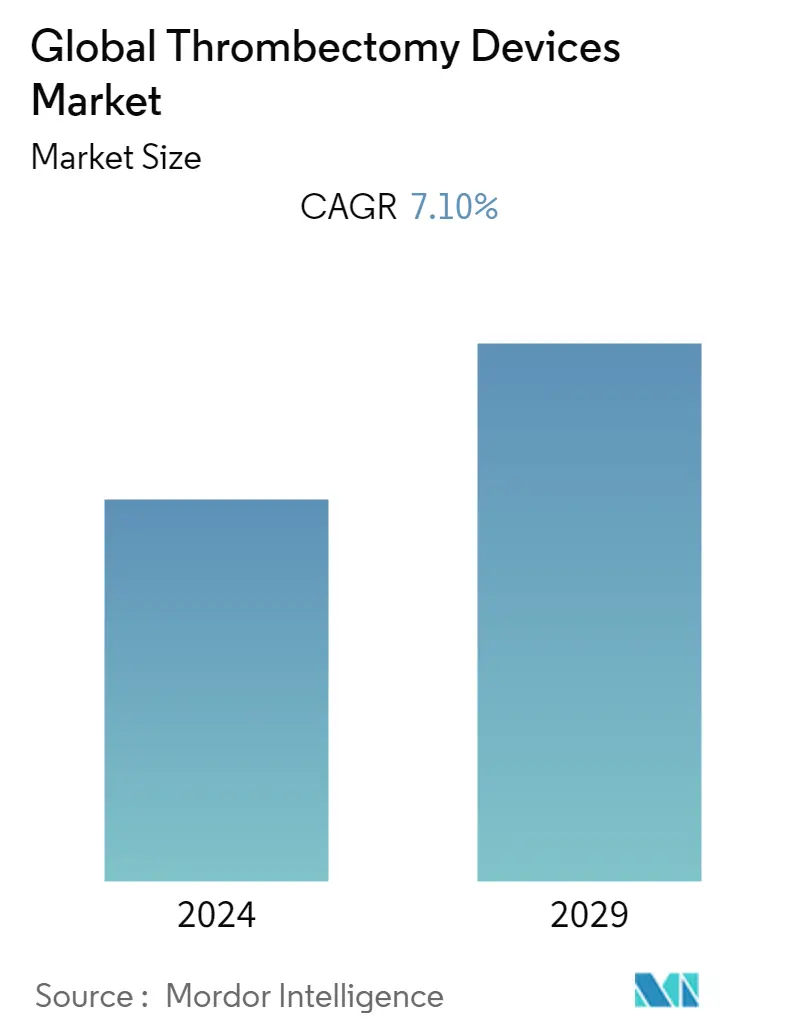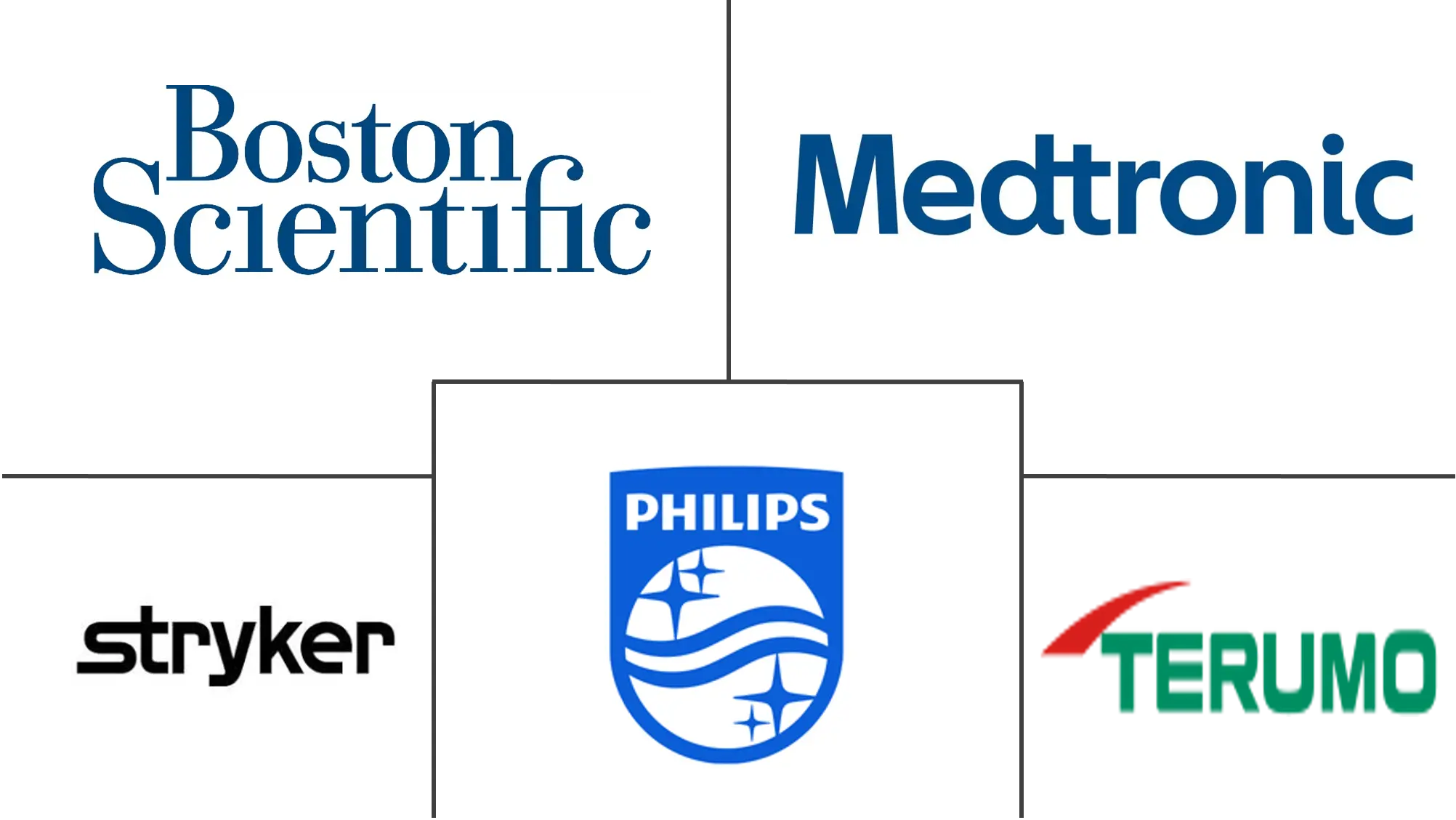Market Size of Global Thrombectomy Devices Industry

| Study Period | 2019 - 2029 |
| Base Year For Estimation | 2023 |
| Forecast Data Period | 2024 - 2029 |
| CAGR | 7.10 % |
| Fastest Growing Market | Asia Pacific |
| Largest Market | North America |
Major Players
*Disclaimer: Major Players sorted in no particular order |
Thrombectomy Devices Market Analysis
The thrombectomy devices market is expected to register a CAGR of 5% over the forecast period (2022-2027).
The COVID-19 outbreak severely impacted the thrombectomy market device market growth. The strict lockdowns and government restrictions have stopped the spread of the virus but slowed down the supply of these devices. Also, the government has applied the guidelines to delay non-essential surgeries, as a result, many surgical procedures were delayed globally and people had suffered a lot due to this. Also, these government restrictions slowed down the neurological procedures and the number of neuro thrombectomy procedures globally. For instance, in 2021 according to the data published by the International Journal of Stroke reported that the number of mechanical thrombectomy procedures got decreased by 12.7% during the initial three months of the pandemic. The onset of the COVID-19 pandemic has led to a rise in patients suffering from chronic diseases. The effects of coronavirus on the health of patients have increased cases of respiratory failures resulting in deaths. At the beginning of the pandemic, a significant decline in the use of mechanical thrombectomy was observed worldwide. Besides, postponement in treatments using mechanical thrombectomy due to infection control measures has as well negatively impacted the market prospects. Although COVID-19 has disrupted several healthcare activities, the thrombectomy devices market continued to witness robust growth. The higher risk of thromboembolism among COVID-19 patients led to increased demand for thrombectomy procedures thereby boosting market revenue.
The main driving features for this market are the growing geriatric population leading to an increase in cardiovascular diseases (CVDs) related to patients, technological advancements in medical devices used for capturing blood clots, and increased awareness regarding the early diagnosis of diseases. The growing geriatric population is leading in driving this market. The world is expected to witness a demographic shift over a few decades and the geriatric population is expected to dominate. Since, the geriatric population and increasing chronic diseases are rising globally and ultimately propelling the demand for thrombectomy devices, thereby contributing to the market growth.
The increasing incidence of ischaemic stroke has introduced the need to launch advanced products on market. The advancement and launch of new devices like suction devices, clot retrievers, and aspiration catheters based on advanced technology for ischaemic stroke are driving the market. For instance, in 2021 Phenox GmbH launched pRESET 6-50 mechanically thrombectomy devices globally to increase its technology for acute ischemic stroke. This product has the longest stent retriever in the phenoxy product portfolio.
The abovementioned aforesaid reasons the market is expected to show significant growth over the forecast period, however shortage of trained professionals, and high cost and difficultly use of devices for complex morphologies, maybe the restrain for this market.
Thrombectomy Devices Industry Segmentation
As per the scope of the report, thrombectomy is an interventional procedure performed to remove clots from a blood vessel. It is commonly performed in coronary arteries, peripheral arteries, and cerebral arteries. The thrombectomy devices market is segmented by Product Type (Aspiration Thrombectomy Devices, Mechanical Thrombectomy Devices, Ultrasonic Thrombectomy Devices, Other Product Types), Applications (Cardiovascular Thrombectomy, Neurovascular Thrombectomy, Peripheral Vascular Thrombectomy), End-User (Hospitals/Clinics, Ambulatory Centers, Other End-Users), and Geography (North America, Europe, Asia-Pacific, Middle East, and Africa, and South America). The market report also covers the estimated market sizes and trends for 17 countries across major regions globally. The report offers the value (in USD million) for the above segments.
| By Product Type | |
| Aspiration Thrombectomy Devices | |
| Mechanical Thrombectomy Devices | |
| Ultrasonic Thrombectomy Devices | |
| Other Product Types |
| By Application | |
| Cardiovascular Thrombectomy | |
| Neurovascular Thrombectomy | |
| Peripheral Vascular Thrombectomy |
| By End User | |
| Hospitals/Clinics | |
| Ambulatory Centers | |
| Other End Users |
| Geography | ||||||||
| ||||||||
| ||||||||
| ||||||||
| ||||||||
|
Global Thrombectomy Devices Market Size Summary
The thrombectomy devices market is poised for significant growth, driven by an increasing geriatric population and the rising incidence of cardiovascular diseases. Technological advancements in medical devices, such as suction devices and clot retrievers, are enhancing the efficacy of thrombectomy procedures, particularly for ischemic strokes. Despite the initial setbacks caused by the COVID-19 pandemic, which led to a temporary decline in procedures due to infection control measures, the market has rebounded as the demand for thrombectomy procedures surged among COVID-19 patients experiencing thromboembolism. The market's expansion is further supported by the growing preference for minimally invasive surgical procedures and favorable reimbursement policies, particularly in regions like North America, where the burden of cardiac diseases is high.
The competitive landscape of the thrombectomy devices market is characterized by the presence of several global and regional players, including Argon Medical Devices Inc., Boston Scientific Corporation, and Medtronic PLC, among others. These companies are actively engaged in strategic initiatives such as mergers and acquisitions to strengthen their market positions. Notable developments include the launch of advanced devices and the acquisition of companies specializing in thrombectomy solutions, which are expected to drive market growth. The fragmented nature of the market, coupled with the continuous introduction of innovative products, underscores the dynamic and competitive environment in which these companies operate.
Global Thrombectomy Devices Market Size - Table of Contents
-
1. MARKET DYNAMICS
-
1.1 Market Overview
-
1.2 Market Drivers
-
1.2.1 Growing Geriatric Population Leading to Increase in CVDs Related Patients
-
1.2.2 Technological Advancements in Medical Devices Used for Capturing Blood Clots
-
1.2.3 Increased Awareness Regarding Early Diagnosis of Diseases
-
-
1.3 Market Restraints
-
1.3.1 Shortage of Trained Professionals
-
1.3.2 High Cost and Difficultly Use of Devices for Complex Morphologies
-
-
1.4 Porter's Five Forces Analysis
-
1.4.1 Threat of New Entrants
-
1.4.2 Bargaining Power of Buyers/Consumers
-
1.4.3 Bargaining Power of Suppliers
-
1.4.4 Threat of Substitute Products
-
1.4.5 Intensity of Competitive Rivalry
-
1.4.6
-
-
-
2. MARKET SEGMENTATION
-
2.1 By Product Type
-
2.1.1 Aspiration Thrombectomy Devices
-
2.1.2 Mechanical Thrombectomy Devices
-
2.1.3 Ultrasonic Thrombectomy Devices
-
2.1.4 Other Product Types
-
-
2.2 By Application
-
2.2.1 Cardiovascular Thrombectomy
-
2.2.2 Neurovascular Thrombectomy
-
2.2.3 Peripheral Vascular Thrombectomy
-
-
2.3 By End User
-
2.3.1 Hospitals/Clinics
-
2.3.2 Ambulatory Centers
-
2.3.3 Other End Users
-
-
2.4 Geography
-
2.4.1 North America
-
2.4.1.1 United States
-
2.4.1.2 Canada
-
2.4.1.3 Mexico
-
-
2.4.2 Europe
-
2.4.2.1 Germany
-
2.4.2.2 United Kingdom
-
2.4.2.3 France
-
2.4.2.4 Italy
-
2.4.2.5 Spain
-
2.4.2.6 Rest of Europe
-
-
2.4.3 Asia-Pacific
-
2.4.3.1 China
-
2.4.3.2 Japan
-
2.4.3.3 India
-
2.4.3.4 Australia
-
2.4.3.5 South Korea
-
2.4.3.6 Rest of Asia-Pacific
-
-
2.4.4 Middle-East & Africa
-
2.4.4.1 GCC
-
2.4.4.2 South Africa
-
2.4.4.3 Rest of Middle-East and Africa
-
-
2.4.5 South America
-
2.4.5.1 Brazil
-
2.4.5.2 Argentina
-
2.4.5.3 Rest of South America
-
-
-
Global Thrombectomy Devices Market Size FAQs
What is the current Global Thrombectomy Devices Market size?
The Global Thrombectomy Devices Market is projected to register a CAGR of 7.10% during the forecast period (2024-2029)
Who are the key players in Global Thrombectomy Devices Market?
Stryker, Boston Scientific Corporation, Medtronic PLC, Terumo Corporation and Koninklijke Philips NV (Spectranetics) are the major companies operating in the Global Thrombectomy Devices Market.

